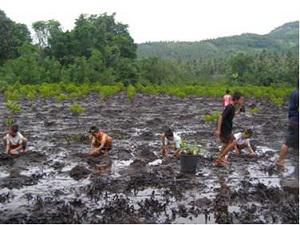Rignolda Djamaluddin
Other projects
29 Sep 2008
Completion of the Project on Cost-Effective Mangrove Rehabilitation Focussing on Restoration of Hydrology
This project will attempt to restore an area of mangrove from disused shrimp farm pond using community participation and focussing on the restoration of hydrology.

The total mangrove areas in the Province of North Sulawesi has been approximated at 4,333 ha. Some 590 ha of these areas had been converted into shrimp ponds including an approximate 20 ha disused shrimp pond complex near the village of Tiwoho, Bunaken National Park, North Sulawesi-Indonesia. Part of these 20 ha hectares were selected to have been prioritized for demonstrating a cost effective mangrove rehabilitation focusing on the restoration of hydrology. Some of the reasons for selection of this site include:

a) strong community involvement in mangrove conservation,
b) proximity to the Coastal Community Resource Center making the site highly accessible for study tours (a good demonstration site),
c) proximity to source of healthy and diverse mangrove seeds/propagules,
d) relative ease of hydrological rehabilitation,
e) status of land ownership as a public group ownership for community of Tiwoho.
Many mangrove rehabilitation projects in Indonesia have experienced technical failure due to the incorrect assumption that degraded coastal lands that were once inhabited by mangroves can be re-established by simply replanting mangrove seedlings. The demonstration site of mangrove rehabilitation at Tiwoho had previously been experienced this technical failure after three to four times replanting. During November 2002 to May 2003 a study focused on the evaluation of the forest ecology and individual ecology of mangrove species, and the evaluation of physical conditions of the project site had been finalized. Result of this study indicated that natural mangrove seedlings are available in the mangrove, however the physical conditions (e.g. elevation, tidal circulation and inundation) of the site have been significantly changed due to the construction of shrimp ponds.
Findings of the study are reported separately in Djamaluddin (2002) and Kabes (2003), and these are used as the basic information for physical rehabilitation of the site that was started on November 2004 with the support of Rufford Small Grant. Physical rehabilitation of the site had been finalised with the successful in secondary succession of new mangrove growth of Avicennia marina, Sonneratia alba and Rhizophora apiculata. This fact indicates the successful in implementing method of hydrological restoration in mangrove rehabilitation process.
Some remaining activities need to be conducted for the completion and development of the project, which include:
1) monitoring and evaluation,
2) site maintenance,
3) village ordinance making,
4) mangrove rehabilitation training,
5) mangrove education.
It is expected that the final achievement of this project will be a comprehensive understanding of hydrological restoration procedure in the field of mangrove rehabilitation program.